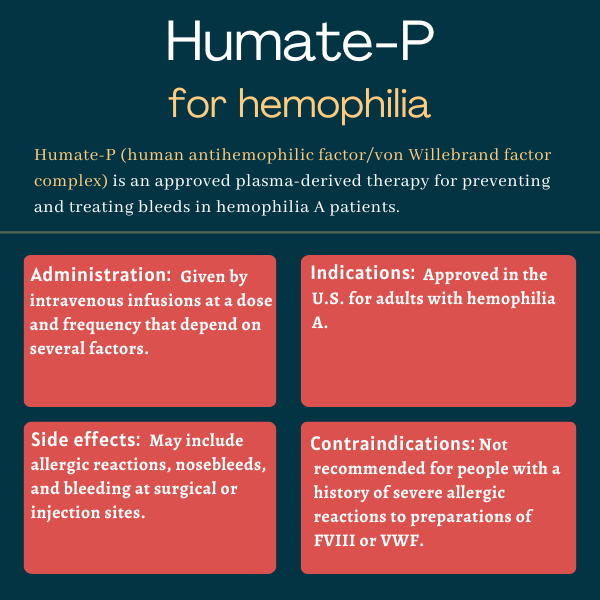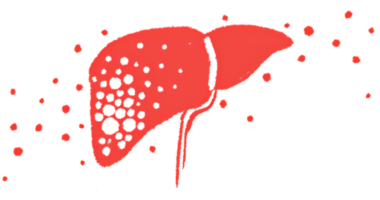Humate-P for hemophila
Last updated Sept. 16, 2025, by Marisa Wexler, MS

What is Humate-P for hemophilia?
Humate-P (human antihemophilic factor/von Willebrand factor complex) is a plasma-derived factor replacement therapy approved to prevent and treat bleeding episodes in adults with hemophilia A.
Marketed by CSL Behring, Humate-P is also approved to manage spontaneous and traumatic bleeds and prevent excessive bleeding during and after surgery in children and adults with von Willebrand disease (VWD).
Hemophilia A and VWD are bleeding disorders marked by deficits in certain blood-clotting proteins, specifically factor VIII (FVIII) in hemophilia A and von Willebrand factor (VWF) in VWD. Humate-P contains versions of both of these proteins that have been purified from human plasma — the non-cellular part of blood — and that may be given to help promote normal clotting.
The therapy is administered via intravenous, or into-the-vein, infusions. In Europe, CSL Behring markets a similar therapy, Haemate-P, which is also approved for similar indications.
Therapy snapshot
| Brand name: | Humate-P |
| Chemical name: | Human antihemophilic factor/von Willebrand factor complex |
| Usage: | Used to prevent and treat bleeding episodes in hemophilia A patients |
| Administration: | Intravenous infusion |
Who with hemophilia can take Humate-P?
Humate-P is approved in the U.S. for treating and preventing bleeding episodes in adults with hemophilia A.
Humate-P is contraindicated, or should not be used by anyone with a history of severe allergic reactions to preparations of FVIII or VWF.
How is Humate-P administered in hemophilia?
Humate-P is administered by intravenous infusions that can be self-administered after training from a healthcare professional on properly storing, preparing, and using the medication.
Specific dosages and treatment schedules are tailored to each patient’s needs, taking into account factors such as weight, bleed severity, FVIII level, and the presence of neutralizing antibodies against FVIII.

Humate-P in hemophilia clinical trials
Clinical studies reporting Humate-P’s clinical efficacy specifically in patients with hemophilia A are limited. Still, pharmacological studies have shown that FVIII levels rapidly rose following the administration of the therapy in those patients. The therapy’s half-life, or the time it remained active in the body before its levels dropped to half of those upon original administration, ranged from 8.4 to 17.4 hours.
Humate-P’s clinical efficacy in controlling bleeds was demonstrated in a retrospective review of data from 97 people with VWD who were given the therapy to manage bleeds in the 1990s. Results showed that Humate-P’s ability to control bleeding was rated as good or excellent in 97% of the events.
Additional evidence was provided by data from two clinical studies — one in the U.S.. and another in Europe — that tested the therapy on 62 people with VWD undergoing surgery. Results showed that investigators rated the therapy’s ability to control bleeding as good or excellent in more than 95% of the cases in the U.S. and the European studies.
Common side effects of Humate-P
The most common side effects of Humate-P are allergic reactions, which can manifest with symptoms that include:
- hives (urticaria)
- rash
- chest tightness
- itching
- swelling
If Humate-P is used during surgery, common side effects include postoperative wound and injection-site bleeding, as well as nosebleeds.
Other important safety considerations associated with the use of Humate-P include:
- People with certain blood types (A, B, or AB) should be monitored for intravascular hemolysis (red blood cell destruction inside blood vessels) and low hematocrit values (low proportion of red blood cells in the blood) when receiving large doses of Humate-P or when the therapy is administered frequently. They should be treated appropriately in case it happens.
- Because Humate-P is made using human blood, there is a theoretical risk that it could pass along bloodborne infectious agents. However, with modern safety procedures, this risk is extremely small.
Hemophilia News Today is strictly a news and information website about the disease. It does not provide medical advice, diagnosis, or treatment. This content is not intended to be a substitute for professional medical advice, diagnosis, or treatment. Always seek the advice of your physician or other qualified health provider with any questions you may have regarding a medical condition. Never disregard professional medical advice or delay in seeking it because of something you have read on this website.
Recent Posts






